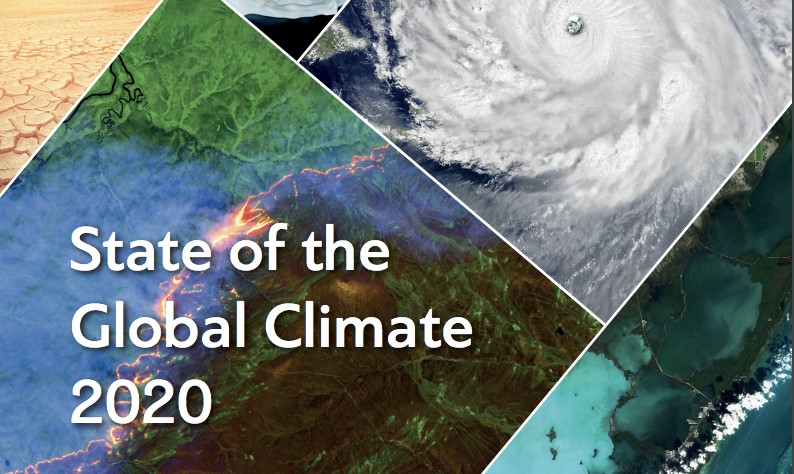

World Meteorological Organization release the State of the Global Climate Report 2020
-
Climate change indicators and impacts worsened in 2020
-
2020 was one of three warmest years on record, despite cooling La Niña
-
Extreme weather and COVID-19 combined in a double blow
The World Meteorological Organization (WMO) has today released its report on the State of the Global Climate 2020. Extreme weather combined with COVID-19 was a double blow for millions of people in 2020. However, the pandemic-related economic slowdown failed to put a brake on climate change drivers and accelerating impacts, according to the WMO and an extensive network of partners.
The report documents indicators of the climate system, including greenhouse gas concentrations, increasing land and ocean temperatures, sea level rise, melting ice and glacier retreat and extreme weather. It also highlights impacts on socio-economic development, migration and displacement, food security and land and marine ecosystems.
2020 was one of the three warmest years on record, despite a cooling La Niña event. The global average temperature was about 1.2° Celsius above the pre-industrial (1850-1900) level. The six years since 2015 have been the warmest on record. 2011-2020 was the warmest decade on record.
“It has been 28 years since the World Meteorological Organization issued the first state of the climate report in 1993, due to the concerns raised at that time about projected climate change. While understanding of the climate system and computing power have increased since then, the basic message remains the same and we now have 28 more years of data that show significant temperature increases over land and sea as well as other changes like sea level rise, melting of sea ice and glaciers and changes in precipitation patterns. This underscores the robustness of climate science based on the physical laws governing the behaviour of the climate system,”
“All key climate indicators and associated impact information provided in this report highlight relentless, continuing climate change, an increasing occurrence and intensification of extreme events, and severe losses and damage, affecting people, societies and economies. The negative trend in climate will continue for the coming decades independent of our success in mitigation. It is therefore important to invest in adaptation. One of the most powerful ways to adapt is to invest in early warning services and weather observing networks. Several less developed countries have major gaps in their observing systems and are lacking state of the art weather, climate and water services.” said WMO Secretary-General Prof. Petteri Taalas.
Prof. Taalas joined United Nations Secretary-General António Guterres in launching WMO’s flagship report at a press conference on 19 April. It comes ahead of the 22-23 April virtual Leaders Summit on Climate, convened by the United States of America. President Biden is seeking to galvanize efforts by the major economies to reduce greenhouse gas emissions and meet the targets of the Paris Agreement on Climate Change to keep temperature increase to well below 2°C above pre-industrial levels by the end of the century, and to 1.5°C if possible.
“This report shows that we have no time to waste. The climate is changing, and the impacts are already too costly for people and the planet. This is the year for action. Countries need to commit to net zero emissions by 2050. They need to submit, well ahead of COP26 in Glasgow, ambitious national climate plans that will collectively cut global emissions by 45 per cent compared to 2010 levels by 2030. And they need to act now to protect people against the disastrous effects of climate change,” said the UN Secretary-General.

In 2020, COVID-19 added a new and unwelcome dimension to weather, climate and water-related hazards, with wide-ranging combined impacts on human health and well-being. Mobility restrictions, economic downturns and disruptions to the agricultural sector exacerbated the effects of extreme weather and climate events along the entire food supply chain, elevating levels of food insecurity and slowing the delivery of humanitarian assistance. The pandemic also disrupted weather observations and complicated disaster risk reduction efforts.
The report illustrates how climate change poses a risk to the achievement of many of the Sustainable Development Goals, through a cascading chain of interrelated events. These can contribute to reinforcing or worsening existing inequalities. In addition, there is the potential for feedback loops which threaten to perpetuate the vicious cycle of climate change.
Information used in this report is sourced from a large number of National Meteorological and Hydrological Services and associated institutions, as well as Regional Climate Centres. UN partners include the Food and Agriculture Organization of the United Nations (FAO), International Monetary Fund (IMF), Intergovernmental Oceanographic Commission of UNESCO (IOC-UNESCO), International Organization for Migration (IOM), the United Nations Environment Programme (UNEP), UN High Commissioner for Refugees (UNHCR), the World Food Programme (WFP) and the World Health Organization.
It updates a provisional version released in December 2020 and is accompanied by a story map on global climate indicators.
You can read the full report here

